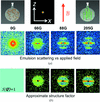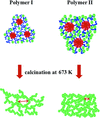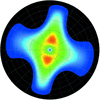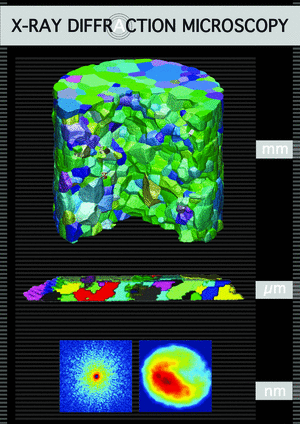issue contents
Small-angle scattering special issue (February 2014)
Guest Editor(s): Elliot Paul Gilbert and Andrew J. Allen
Guest Co-editor(s): Yoshiyuki Amemiya, Aldo Craievich, Charles Dewhurst, Andrew Jackson and Dmitri Svergun
This virtual special issue of Journal of Applied Crystallography provides an overview of the state of the art across the spectrum of small-angle neutron and X-ray scattering, covering the fields of application, theory, methods of analysis and instrumentation. The issue collects together a series of articles originally published in the journal between October 2013 and February 2014.

Cover illustration: Colour-coded intensity map of a time-resolved small-angle X-ray scattering experiment following the osmotic shrinkage of a pharmacologically relevant liposomal system. Courtesy of Varga et al. [J. Appl. Cryst. (2014), 47, 35–40].
Free 

Journal of Applied Crystallography is pleased to announce a virtual issue presenting articles based on some highlights of the 15th International Small-Angle Scattering Conference (SAS2012) This special issue collects together a series of articles originally published in the journal between October 2013 and February 2014 and is available at //journals.iucr.org/special_issues/2014/sas2012/.
The guest exchange process in co-crystals of syndiotactic polystyrene has been studied by in situ time-resolved small-angle neutron scattering measurements, exploiting the scattering length difference between fully protonated and deuterated guest molecules. From the intensity change of lamellar reflections, the diffusion coefficients of guest molecules in the crystalline region could be evaluated.
Recent developments on the experimental infrastructure and the acquisition of new detectors on the small/wide-angle X-ray scattering (SAXS/WAXS) Dutch–Belgian beamline BM26B at the ESRF offer novel and promising possibilities for synchrotron X-ray experiments in the field of polymer crystallization under processing-relevant conditions.
To clarify the formation of stereo-complex crystals of poly(L-lactic acid) and poly(D-lactic acid) blends under shear flow, the structure was analyzed using time-resolved in situ X-ray scattering, optical microscopy, differential scanning calorimetry and viscoelastic measurements. Density fluctuations of 100 nm scale were observed prior to nucleation by in situ simultaneous wide- and small-angle X-ray scattering measurements.
Thermosensitive charged triblock copolymers have been investigated using SAXS. It was found that the temperature response of the micelles formed at elevated temperatures is dependent on the nature of the charged group.
Internal structures of polymer micelles of poly(4-vinylphenol)-block-poly(4-bromostyrene) in alkaline solution are characterized using anomalous small-angle X-ray scattering near the Br and Rb K edges.
Scattering experiments with nano- and micrometre sized X-ray beams and a filtration setup with silicon micro-sieves as membranes are reported. As a result of the filtration forces, spherical casein micelles assume an ellipsoidal shape while their volumes remain constant.
Combining small-angle neutron scattering and small/wide-angle X-ray scattering techniques is a suitable approach for studying a nanostructured mixture solvent, especially near the immiscibility gap and far from a critical point.
The osmotic water permeability and changes in the bilayer structure during the osmotic shrinkage of a pharmacologically relevant liposomal system have been studied using time-resolved small-angle X-ray scattering.
Synchrotron small-angle X-ray scattering was used to characterize the morphology of SiO2/TiO2 hollow nanoparticles and the morphology of their composites with freeze-dried polymer scaffolds.
Compound refractive lens focused small-angle neutron scattering was applied to the magnetic chaining technique of force measurements between the particles of a monodisperse ferrofluid emulsion. The analysis required careful treatment of resolution effects and also revealed chain transverse correlations indicating the formation of transient intermediate structures at lower applied fields.
Self-assembled structures of a Pluronic F127 triblock copolymer with an organic derivative in an aqueous solution are reported.
Small-angle X-ray scattering and light scattering studies of mixed micelles of thermoresponsive triblock copolymer F127 and thermoresponsive statistical polyoxazolines are described.
An empirical relation was found to estimate the average number of platelets per tactoid as follows: 〈N〉 = δ + α〈D〉, where δ is a constant and α the slope.
Anomalous small-angle X-ray scattering (ASAXS) is applied to structurally characterize the hindered growth process of CaF2 nanocrystals in an SiO2-based oxide glass resulting in a transparent glass ceramic.
A structure–function investigation, using anomalous small-angle X-ray scattering and UV–Vis spectroscopy, leads directly to a mechanistic proposal of cascade catalysis of Au/Pd nanoparticles.
The effect of additive on the nanostructure of a calcium-based hydrogen storage material investigated using anomalous small-angle X-ray scattering and X-ray absorption spectroscopy is reported.
Small-angle X-ray diffraction mapping shows a strong correlation between the longitudinal pore alignment within an anodic alumina film and the grain structure of an aluminium substrate.
Neutron and X-ray reflectivity, as well as small-angle scattering, are used to probe the in-plane and surface-normal structure of anodized aluminium. A new low-voltage anodization protocol gives smooth anodic films on aluminium, suitable for investigation by neutron and X-ray reflectivity.
Periodic Co/SiO2 multilayers deposited by magnetron sputtering were investigated by grazing-incidence small-angle X-ray scattering, X-ray diffraction and the time-of-flight elastic recoil detection analysis method. During the deposition, Co nanoparticles are created and order spontaneously, forming a three-dimensional periodic array.
Zinc oxide network structures resembling a foam-like morphology are synthesized via a sol–gel route using a structure-directing diblock copolymer with different molecular weights. Grazing-incidence small-angle X-ray scattering has been used to study the variation in porosity and the average pore size of the films, thereby enabling fine tuning of the morphology depending on the final application.
The indirect Fourier transformation technique is extended to two-dimensional small-angle scattering patterns of oriented samples.
A versatile procedure to build high-symmetry objects and calculate their corresponding theoretical small-angle scattering intensity is presented, enabling the modelling and fitting of experimental data for very complex models.
This article describes the concept, layout and expected performance of the new Bonse–Hart ultra-small-angle neutron scattering instrument Kookaburra at the ANSTO OPAL facility.
Round-robin measurements of polystyrene latex samples at a number of small-angle scattering facilities have been used to assess the current limits of reliability and reproducibility of scattering data, as well as the accuracy of parameters derived from subsequent analysis such as the radius and polydispersity. These results are used to develop understanding and improve the technique.


 journal menu
journal menu










































